I'd never made buttercream before, and this recipe was perfect. It was smooth, creamy, and the vanilla added a lovely flavor.
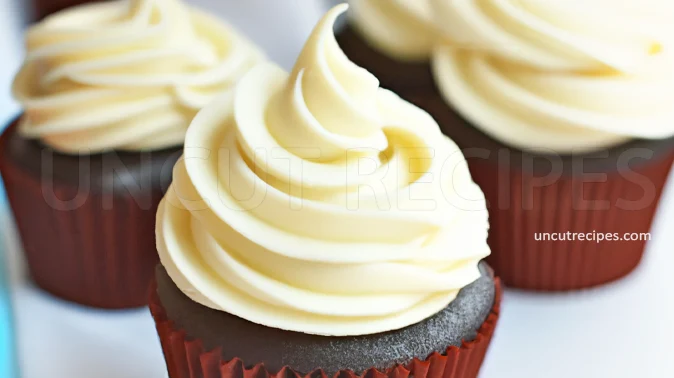
Buttercream, or バタークリーム as it's known in Japan, is like a sweet symphony for the taste buds. It's the velvety embrace that makes cakes, cupcakes, and pastries truly come to life. But did you know that this seemingly simple frosting carries a universal language of love, appreciation, and celebration?
Imagine a bustling patisserie in Tokyo. The glass case is lined with enchanting cakes, each one a canvas adorned with intricate Buttercream artistry. A young couple stands by, selecting a cake for their first anniversary. The choice is unanimous - a cake frosted with Buttercream roses, each petal a testament to their blossoming love.
Buttercream isn't just a frosting; it's a medium that bakers use to translate emotions into something tangible. It's a gift, a gesture, a moment frozen in time that says, "This is special, and so are you."
This Buttercream recipe invites you into the magical world of sweet creation. As you whisk the Egg Whites and Sugar, feel the anticipation building, knowing that something extraordinary is about to unfold. Each step, from warming the mixture to that final swirl of Vanilla, is a dance of flavors and textures that will culminate in a spreadable masterpiece.
Perhaps you're not an artist with a paintbrush, but with this Buttercream, you'll discover the joy of painting with flavors. A birthday wish, a heartfelt thank you, or a simple "I care" - your Buttercream creations will speak volumes.
Have you ever stopped to think about the cakes at the family celebrations, the cupcakes at the community fundraisers, or the pastries at the friendly get-togethers? Behind each delicious bite, there's a story, a connection, a shared experience, and Buttercream often plays a starring role.
So, get your whisk and your spatula ready. Today, you're not just making a frosting; you're weaving joy, love, and creativity into something that tastes like happiness. Whether you're a baking novice or a seasoned pro, this Buttercream recipe will guide you to create something that's not just tasty but truly heartfelt.
Ready to spread some love? Let's dive into the beautiful world of Buttercream!
JUMP TO:
INGREDIENTS:
Fresh and Properly Separated Egg White: A large, fresh egg white is needed for stability and lightness in the buttercream. It's crucial to separate the egg white without any yolk contamination, as even a small amount of yolk can affect the whipping process. Using eggs at room temperature will help in creating a smooth and glossy texture.
Allergen Considerations and Substitutes: For those with dietary restrictions, egg-free or dairy-free alternatives are available. For an egg-free version, aquafaba (chickpea liquid) can be used, and for dairy-free, a vegan butter substitute can be considered. Be aware that these alternatives may slightly alter the taste and texture of the buttercream.
MAIN STEPS:
Ensuring Proper Whisking Technique in Initial Mixing: In Step 01, it's essential to whisk the egg whites and sugar smoothly. Any lumps or inconsistency can lead to issues later on. The egg whites must be whipped to the correct consistency to form a stable base for the buttercream. Patience and attention to the texture are key here.
Monitoring Temperature and Texture in Double Boiler: Step 02 involves heating the mixture over a double boiler. Monitoring the temperature or feeling for the complete dissolution of sugar is crucial. Overheating may cook the egg whites, leading to lumps, whereas not reaching the desired temperature can leave sugar grains undissolved, resulting in a gritty texture.
Achieving Hard Peaks: The whipping process in Step 03 must be done until hard peaks form. This stage is vital for the structure of the buttercream. Whipping too little will leave the buttercream weak and runny, while over-whipping can make it too stiff and hard to work with. The cooling to room temperature also helps ensure the butter blends smoothly in the next step.

Gradual Incorporation of Butter: Step 04 requires careful attention to adding the butter gradually. Adding it too quickly may cause the buttercream to break or curdle. Ensuring the butter is at room temperature and mixing it in a tablespoon at a time is crucial for a smooth and creamy texture.
SERVED WITH:
Dessert: Vanilla Cupcakes (United States): Soft, moist vanilla-flavored cupcakes often topped with buttercream frosting. The buttercream adds richness and sweetness to these classic American treats.
Cake: Victoria Sponge Cake (United Kingdom): A traditional British cake made of two sponge cakes sandwiched with jam and buttercream. The buttercream provides a creamy contrast to the fruitiness of the jam.
Drink: Hot Chocolate (France): A rich and comforting beverage made from melted chocolate and hot milk. In France, a dollop of flavored buttercream on top adds a luxurious touch.
Pastry: Éclairs (France): Elongated pastries filled with cream and topped with buttercream or chocolate glaze. The buttercream adds an extra layer of flavor and texture to this French delicacy.
Dessert: Carrot Cake (United States): A moist cake made with grated carrots and typically frosted with cream cheese or buttercream frosting. The buttercream enhances the spiced flavor of this popular American dessert.
Cake: Black Forest Cake (Germany): A layered chocolate cake with cherries and whipped cream, sometimes complemented with buttercream. The buttercream adds a sweet and buttery dimension to this classic German cake.
Dessert: British Swiss Roll (Britain): A rolled sponge cake filled with jam or cream, and sometimes buttercream. In the UK and Switzerland, buttercream is used to add richness and sweetness to this delicate dessert.
Drink: Coffee with Buttercream (Various): Some cultures add a small dollop of butter or flavored buttercream to black coffee. The buttercream enriches the coffee and cuts the bitterness, creating a smoother, creamier beverage.
ALTERNATIVES:
Dessert: Tres Leches Cake (Mexico): This moist cake is soaked in three kinds of milk and topped with a whipped cream frosting, sharing the creamy and sweet characteristics of buttercream.
Cake: Sachertorte (Austria): A dense chocolate cake, layered with apricot jam, and covered with a glossy chocolate glaze. While not using buttercream directly, the glaze and the cake's texture can be compared to buttercream's richness.
Pastry: Pâte à Choux (France): A light pastry dough used in many French pastries like profiteroles and cream puffs. The dough shares the butter and richness of buttercream, and it can be filled with a variety of creamy fillings.
Dessert: Cream Cheese Frosting (United States): Often used as an alternative to buttercream in cakes and cupcakes, it’s made with butter, cream cheese, powdered sugar, and vanilla, providing a tangy yet sweet taste.
Cake: Mille-Feuille (France): Also known as Napoleon, it’s made with layers of puff pastry and pastry cream. The creamy texture and buttery flavor of the pastry cream align with the qualities of buttercream.
Dessert: Dulce de Leche (Argentina): A sweet milk-based sauce that's often used in desserts in place of or in combination with buttercream, offering a caramel-like flavor and smooth texture.
Cake: Lamingtons (Australia): Sponge cake coated in a layer of chocolate sauce and desiccated coconut. The chocolate sauce can be made with ingredients similar to buttercream, including butter and sugar, giving a rich and smooth taste.
HISTORY:
Buttercream, known as バタークリーム in Japan, is a type of icing or filling used inside cakes and pastries. While the basic ingredients of buttercream (butter and sugar) have been utilized in confections for centuries, the specific origin and growth of buttercream can be traced back to different cultures.
The precise origins of buttercream are not entirely clear, but the creation of this smooth and creamy frosting can be traced back to European culinary traditions. The method of creaming butter and sugar together dates back to at least the Renaissance era, with variations on this theme found across Europe.
Buttercream became popular in France and Switzerland, where chefs developed specific techniques and recipes that differ in texture and flavor. French buttercream, for instance, is known for its richness and is made with egg yolks. Swiss buttercream, on the other hand, uses egg whites and is known for its silky texture.
In the United States, American buttercream, known for its simplicity and sweetness, emerged as a favorite frosting for cakes and cupcakes. It typically contains butter, confectioners' sugar, milk, and flavoring.
Japan adopted buttercream relatively recently, infusing it with its own culinary sensibilities. Japanese buttercream is often lighter and less sweet compared to its Western counterparts. The Japanese have a long-standing tradition of adopting and adapting Western culinary practices, and buttercream is no exception. The inclusion of buttercream in various Japanese pastries and cakes has become a symbol of Western influence on Japanese patisserie.
Today, buttercream is a fundamental ingredient in baking and cake decoration around the world. Different regions have their unique takes on this classic recipe, catering to local tastes and preferences.
TIPS:
Use European-Style Butter: European butter usually has a higher fat content. This can enhance the creaminess and flavor of the Buttercream. Be cautious with the measurements, as it may change the final consistency.
Age the Egg Whites: A trick used by professional patissiers is to age the egg whites by leaving them uncovered in the fridge for 24 hours. This reduces the moisture content and can create a more stable meringue.
Invest in a Sugar Thermometer: For perfect results, using a sugar thermometer is highly recommended. Professionals depend on accurate temperature readings to know precisely when the sugar and egg whites have reached the ideal consistency.
Use a Copper Bowl: Whipping egg whites in a copper bowl can improve their stability due to a reaction between the copper and egg proteins. This might lead to a more resilient and glossy meringue.
Emulsify the Butter: Before adding the butter, consider whipping it separately until it's pale and fluffy. This can create a lighter, smoother texture in the final Buttercream.
Use Vanilla Bean: Instead of extract, scrape the seeds from a vanilla bean pod. This adds a more potent vanilla flavor and delightful visual specks to the Buttercream.
Incorporate Liquor or Liqueurs: For a grown-up twist, flavors like Grand Marnier, Chambord, or quality bourbon can be carefully blended into the Buttercream.
Airbrush Coloring: If you want to add color, using an airbrush can create a subtle hue without affecting the consistency. This is a high-level patisserie technique for picture-perfect results.
Consider Allergen-Free Alternatives: Explore using aquafaba (chickpea water) instead of egg whites for a vegan option, or other creative substitutions to cater to various dietary requirements.
Serve at Optimal Temperature: Understanding the ideal serving temperature for your Buttercream (especially if flavored uniquely) can enhance the flavor experience. Some Buttercreams might need to be closer to room temperature, while others benefit from slight chilling.
Recipe Information
Skill Level
|
Time 30 Minutes |
Price
|
Makes 3 to 10 Cups |
| Healthiness |
Nutritional Information |
| Ratings (Add Rating & Review) |
Reviews 25 Reviews |
Ingredients:
-
1.25 cup Butter
( room temperature, cut into small cubes )
5 large Egg Whites
0.75 cup Sugar
1 teaspoon Vanilla Extract
Allergens
| Dairy | Eggs |
Directions:
01 - Separate the Egg Whites from the Yolks, ensuring that you'll be using only the Whites for the Buttercream. Be extra careful during this process to prevent any Yolk from mixing with the Egg Whites, as even a small amount can affect the final texture.
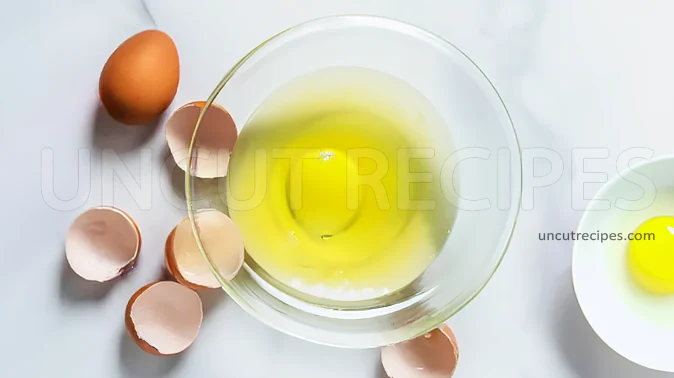
02 - Start with a large bowl, and inside, whisk together the Egg Whites and Sugar. You're aiming for the Egg Whites and Sugar to blend smoothly, creating a unified mixture.
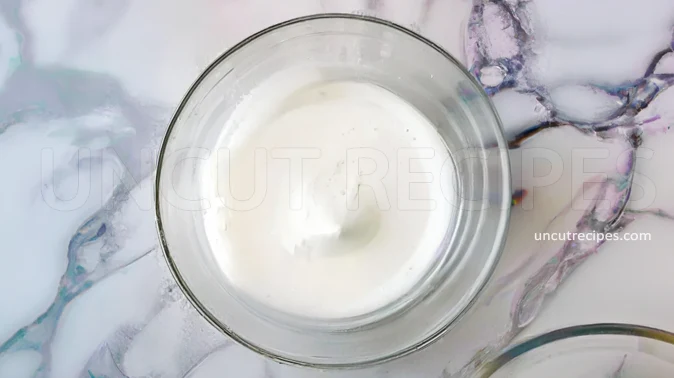
03 - Now, create a double boiler by placing the bowl over a pot filled with water that's gently simmering on low heat. Continue to whisk the mixture in the bowl constantly as it warms up. You'll know it's ready when it reaches a temperature of about 60°C (140°F). If you don't have a thermometer, you'll be looking for the sugar to completely dissolve into the Egg Whites, creating a hot and smooth texture.

04 - Transfer the warmed mixture to a stand mixer. Use the whipping attachment to whip the mixture until hard peaks form. This means that when you lift the whisk, the mixture will hold a firm shape that doesn't collapse. You want to continue whipping for around 10 minutes or until the meringue (the whipped Egg Whites and Sugar) becomes shiny and has cooled down to room temperature.
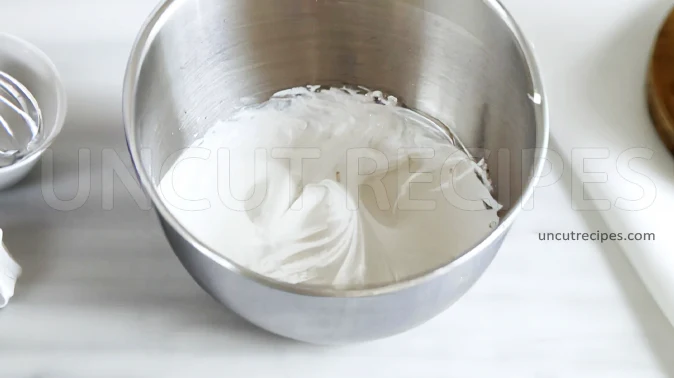
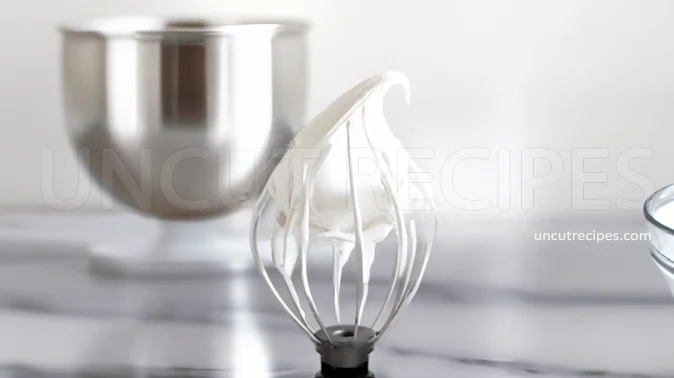
05 - Now, change the attachment on your stand mixer to a paddle. This attachment is flatter and used for creaming. Begin to add Butter to the mixture, a couple of tablespoons at a time, blending it in gradually. The paddle will help incorporate the Butter smoothly.
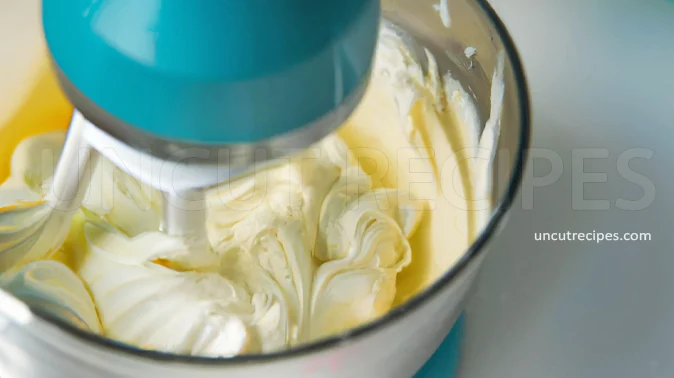
06 - While the machine is working, use a spatula to scrape the sides and bottom of the bowl every once in a while. This ensures that all the Butter is well incorporated into the mixture. Continue this process of adding and scraping until all the Butter has been blended in, and the texture is smooth and creamy.
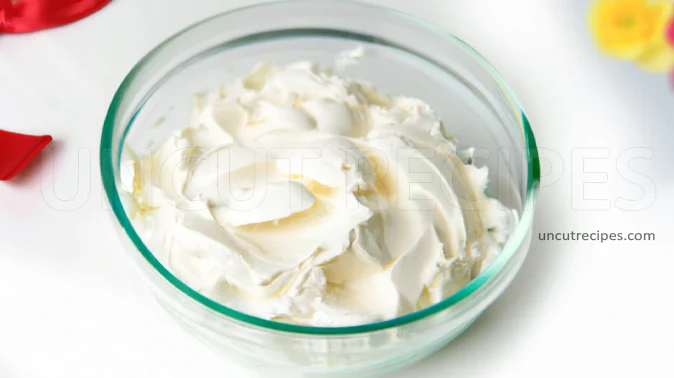
07 - Finally, with the machine still running, add the Vanilla. This will infuse the Buttercream with a delightful aroma and flavor. Mix just enough to evenly distribute the Vanilla throughout the Buttercream. Voilà! You have now made a luscious Buttercream, ready to be spread or piped onto your favorite cakes and cupcakes. Enjoy the silky, rich texture and the joy of creating something so delicious from scratch!
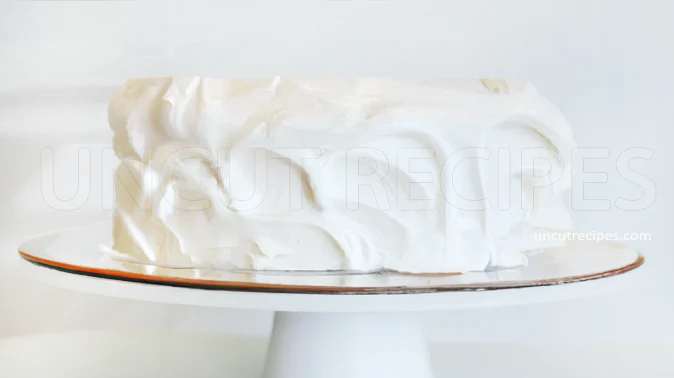
Notes:
Whipping to Hard Peaks: It's essential to reach hard peaks for the correct texture. Underwhipping can result in a runny mixture, while overwhipping might dry it out.
Flavor Variations: You can replace or add to the vanilla extract with other flavors like almond extract, citrus zest, or even some cocoa powder for a different flavor profile.
Refrigeration: If not using immediately, store the buttercream in an airtight container in the refrigerator for up to one week. You'll need to re-whip it before using to restore its creamy texture.
Freezing: Buttercream can be frozen for up to three months. Thaw it in the refrigerator overnight, then whip again before use.
Mixer Attachments: Using the right attachments at each step (whipping for meringue and paddle for creaming) is essential for the texture of the buttercream.
Without a Stand Mixer: If you don't have a stand mixer, a hand mixer can be used, but it may take more time and effort.
Thermometer Use: A candy or digital thermometer is useful for checking the temperature of the egg white-sugar mixture, although not necessary if you're comfortable checking for dissolved sugar by feel.
Nutritional Information
( Per Portion )
|
Calories |
170 kcal (9%) |
| Total Carbohydrate | 12g (4%) |
| Cholesterol | 0mg (0%) |
|
Total Fat |
12g (18%) |
| Saturated Fat | 7g (35%) |
| Polyunsaturated Fat | 0.5g |
| Monounsaturated Fat | 3g |
| Trans Fat | 0g |
| Fibers | 0g (0%) |
| Protein | 4g (8%) |
| Sugar | 11.7g (46.8%) |
|
Vitamin A |
355 IU (7%) |
|
Vitamin B1 (Thiamin) |
0.01mg (1%) |
| Vitamin B2 (Riboflavin) | 0.02mg (1.5%) |
| Vitamin B3 (Niacin) | 0.1mg (0.6%) |
| Vitamin B5 (Pantothenic Acid) | 0.2mg (4%) |
| Vitamin B6 | 0.01mg (0.5%) |
| Vitamin B7 (Biotin) | 2mcg (6%) |
| Vitamin B9 (Folate) | 2mcg (0.5%) |
| Vitamin B12 | 0mcg (0%) |
| Vitamin C | 0mg (0%) |
| Vitamin D | 0 IU (0%) |
| Vitamin E | 0.3mg (2%) |
| Vitamin K | 1mcg (1%) |
| Choline | 15mg (3%) |
| Carnitine | - |
|
Calcium |
6mg (0.5%) |
|
Chloride |
- |
| Chromium | - |
| Copper | 0.01mg (1%) |
| Fluoride | - |
| Iodine | - |
| Iron | 0.1mg (0.5%) |
| Magnesium | 3mg (7%) |
| Manganese | 0.01mg (0.4%) |
| Molybdenum | - |
| Phosphorus | 15mg (1.2%) |
| Potassium | 20mg (0.4%) |
| Selenium | 2mcg (3%) |
| Sodium | 135mg (6%) |
| Sulfur | - |
| Zink | 0.1mg (0.9%) |
* Percent Daily Values are based on a 2,000 calorie diet. Your daily values may be higher or lower depending on your calorie needs.
** Nutrient information is available for all ingredients in this recipe. Amount is based on available nutrient data collected from all over the internet.
(-) Information is not currently available for this nutrient. If you are following a medically restrictive diet, please consult your doctor or registered dietitian before preparing this recipe for personal consumption. |
| Written by: Uncut Recipes | Disclaimer |


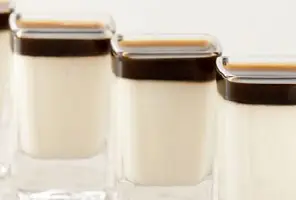

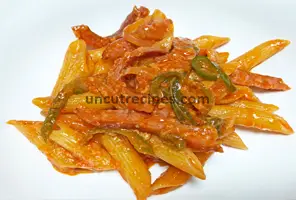
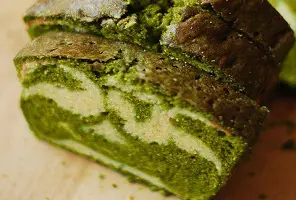
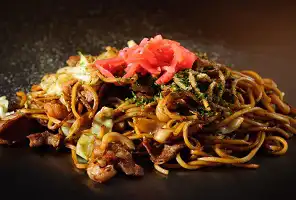
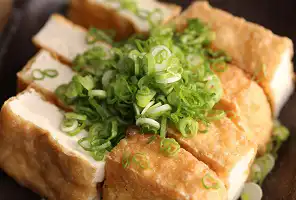


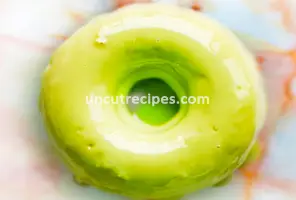
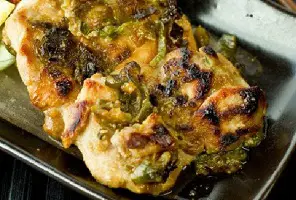
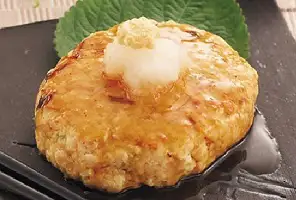

August 12, 2023
First Time Making Buttercream and it's awesome! Thanks!